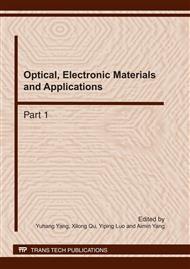[1]
L.Z. Xu, Y. Li, F. Qin: Progress and application foreground of thin film solar cells. Renewable Energy. NO. 3 (2006), p.9.
Google Scholar
[2]
M.H. Weng, R. Mahapatra, P. Tappin, et al: High temperature characterization of high-κdielectrics on SiC[J]. Materials Science In Semiconductor Processing. Vol. 9 (2006), pp.1133-1136.
DOI: 10.1016/j.mssp.2006.10.032
Google Scholar
[3]
T.P. Chow: Silicon carbide power devices[M]. Handbook Of Thin Film Devices. (2000), pp.249-298.
DOI: 10.1016/b978-012265320-9/50074-x
Google Scholar
[4]
R.Y. Jin, Z.M. Chen, H.B. Pu, et al: Photoelectric characteristics of SiC1-xGex/SiC heterojunction diode[J]. Acta Photonica Sinica, Vol. 34 (2005), p.205.
Google Scholar
[5]
M. Ma, S. Aoyama, H. Okamoto, Y. Hamakawa: Solar Energy Materials and solar Cells. Vol. 41-42 (1996), p.453.
DOI: 10.1016/0927-0248(95)00137-9
Google Scholar
[6]
G. Foti: Appl. Surf. Sci. Vol. 184 (2001), p.20.
Google Scholar
[7]
A. Ordine, C.A. Achete, O.R. Mattos, I.C.P. Margarit, S.S. Camargo Jr, T. Hirsch: Surf. Coat. Technol. Vol. 133-134 (2000), p.532.
Google Scholar
[8]
J. C. Zolper, M. Skowronski: Materials Research Society . Vol. 30 (2005), p.273.
Google Scholar
[9]
X. Y. Han, G. J. Li, G. F. Hou, et al : Effect of n Doped Layers in an Amorphous Silicon Top Solar Cell on the Performance of Micromorph, Tandem Solar Cells. Journal of Semiconductors . Vol. 29 (2008), p.1548.
Google Scholar
[10]
X. D. Zhang, Y. Zhao, F.H. Sun , et al: N-type window layer and its application in high depos- ition rate microcrystalline silicon solar cells. Acta Physica Sinica. Vol. 58(2009), pp.5401-5405.
Google Scholar
[11]
J. Koh, Y. H. Lee, H. Fujiwara, et al: Appl Phys Lett[J]. Vol. 73(1998), p.1526.
Google Scholar
[12]
Y. Xu, H. W. Diao, S. B. Zhang, et al: Deposition of p-type nc-SiC: H thin films with subtle carbon incorporation for applications in p-i-n solar cells. Acta Photonica Sinica. Vol. 56(2007), p.2916.
Google Scholar
[13]
W. Yu, J. Du, L. Zhang, et al : Efect of H2 Flow Rate on Microstructure and Optical Property of Nano-crystalline SiC Films. Journal of Inorganic Materials. Vol. 23(2008), p.541.
Google Scholar
[14]
W. Zhao, Z. Y. Zhang, C. X. Zhai, et al: Influence of Hydrogen Flow on Grain size of Nano-crystalline SiC Films Grown by HFCVD Method. Acta Photonica Sinica. Vol. 38(2009), p.825.
Google Scholar



